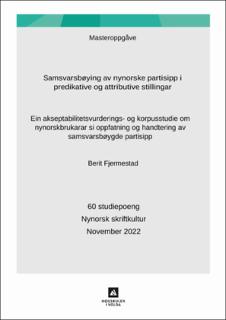| dc.contributor.author | Fjermestad, Berit | |
| dc.date.accessioned | 2023-01-13T08:42:18Z | |
| dc.date.available | 2023-01-13T08:42:18Z | |
| dc.date.issued | 2022 | |
| dc.identifier.uri | https://hdl.handle.net/11250/3043241 | |
| dc.description.abstract | I denne masteroppgåva prøver eg å få konkrete tal på korleis nynorskbrukarar oppfattar og handterer samsvarsbøying av partisipp. På nynorsk er det valfri samsvarsbøying av svake partisipp som står i predikativ stilling, difor kan ein til dømes velje om ein vil samsvarsbøye partisippet og skrive «Hytta er bygd» eller unngå å samsvarsbøye partisippet og skrive «Hytta er bygt». Problemstillinga i denne oppgåva er difor: Korleis oppfattar og handterer dei nynorske språkbrukarane samsvarsbøying av partisipp?
Eg svarar på problemstillinga ved hjelp av desse tre meir konkrete forskingsspørsmåla:
1. Korleis oppfattar og handterer nynorskbrukarane valfri samsvarsbøying av svake partisipp i predikativ stilling?
2. Korleis oppfattar og handterer nynorskbrukarane obligatorisk samsvarsbøying av sterke og svake partisipp?
3. På kva måte spelar dialekttilhøyrsle inn på nynorskbrukarane si oppfatning av samsvarsbøying av partisipp?
Eg brukar akseptabilitetsvurderings- og korpusstudiar som hjelp til å svare på forskingsspørsmåla. I tillegg brukar eg regresjonsmodellar og hierarkiske klassifikasjonsmodellar som statistiske modellar for å betre kartlegge korleis denne samsvarsbøyinga blir handtert og oppfatta av nynorskbrukarane. Resultata frå akseptabilitetsvurderingane viser mellom anna at respondentane føretrekker samsvarsbøygde former framfor ikkje-samsvarsbøygde former. I korpusundersøkingane derimot held tekstskrivarane seg i stor grad til rettskrivingsreglane, og dei brukar dei valfrie samsvarsbøygde og ikkje-samsvarsbøygde svake partisippa i predikativ stilling så og sei like ofte. | en_US |
| dc.description.abstract | Abstract
In this master’s thesis I try to quantify Nynorsk users’ perception and production of text with participle agreement. Nynorsk has optional agreement in weak participles in predicative form, and it is therefore optional to use agreement in sentences such as “Hytta er bygd” (agreement) or “Hytta er bygt” (without agreement). The research question of this thesis is: How do Nynorsk users perceive and produce text with participle agreement?
I explore this question closer by using the following sub-questions:
1. How do Nynorsk users perceive and produce text with optional participle agreement in predicative forms?
2. How do Nynorsk users perceive and produce text with mandatory participle agreement in attributive forms?
3. How do Nynorsk users’ dialects influence the perception and production of text with participle agreement?
I use a combination of acceptability judgement tasks and text corpus studies as methods to answer the research questions. In addition, I use regression models and hierarchical classification tree models as statistical methods to better understand Nynorsk users’ perception and production of participle agreement. The results from analyzing the acceptability judgement tasks shows that the respondents prefer sentences with participle agreement (Hytta er bygd) rather than sentences without agreement (Hytta er bygt). However, in the corpus study the results indicate that the writers use both forms equally, and when the participle agreement is mandatory, they tend to follow the grammatical rule. | en_US |
| dc.language.iso | nno | en_US |
| dc.publisher | Høgskulen i Volda | en_US |
| dc.title | Samsvarsbøying av nynorske partisipp i predikative og attributive stillingar. Ein akseptabilitetsvurderings- og korpusstudie om nynorskbrukarar si oppfatning og handtering av samsvarsbøygde partisipp | en_US |
| dc.type | Master thesis | en_US |
| dc.source.pagenumber | 122 | en_US |
